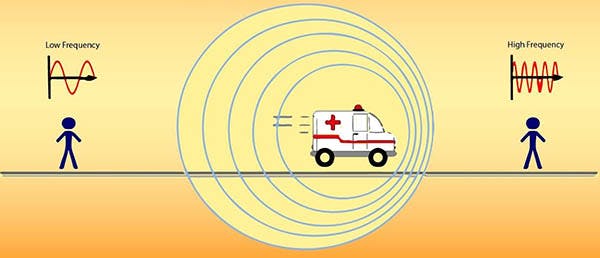When a truck sounding a horn approaches you, the horn’s pitch increases gradually and is highest as the truck passes near you.
As the truck recedes, the pitch gradually decreases. The variation in sound as the source approaches the receiver and as it moves away is caused by the Doppler Effect.
The Doppler Effect, also known as the Doppler shift, is observed when light and sound move towards or away from the observer.
As the source of sound moves towards the observer, the frequency of the sound waves increases.
An increase in the frequency of the sound waves raises the pitch of the sound. As the sound source moves away from the observer, the sound waves stretch out, causing their frequency to decrease. A decrease in frequency lowers the pitch of the sound.
Doppler Effect is the change in wavelength of sound or light waves caused by relative motion between the source and the observer.
Doppler Effect is only produced by movement towards or away from the observer (along the line of sight).
Blueshift and Redshift
In astronomy, Doppler Effect is produced by light waves. As the source of light moves towards the observer, wavelength decreases. The waves move towards the blue end of the spectrum; this is called the blue shift.
As the source of light moves away from the observer, wavelength increases. The waves move towards the red end of the spectrum; this is called redshift.
The mathematical expression for the Doppler Effect is given as;
Where: ∆λ is the change in wavelength
λο the initial wavelength
V is the velocity of the source of light
C is the speed of light
Here are some of the applications of the Doppler effect in astronomy:
1. Estimating how fast the galaxies and stars are moving away from the earth

Astronomers can work out the velocity of stars and galaxies that emit light in space.
The speed obtained shows the extent to which these bodies are moving away from the earth.
The velocity obtained helps astronomers know the relationship between the color of a star and its position in the universe.
2. Determining rotation of planets
Astronomers use Doppler Effect to study the rotation and rotational period of planets in space.
They do this by studying the distance of stars in the planets at different times.
This study helps them estimate the planet’s time to complete a rotation.
3. Determining the chemical composition of stars and galaxies
Astronomers determine the elements present in stars and galaxies by studying their spectrum.
Different elements and compounds show unique dips on the spectrum of an object.
This has helped astronomers know the elements and compounds found in space.
4. Study of movement of bodies in space

Astronomers apply the Doppler Effect to study the movement of objects across the universe.
As stars and planets move in space, they emit and reflect light.
The Doppler Effect caused by the light waves helps astronomers study the revolution of the objects in space.
5. Expansion of space is measured by redshift
Astronomical studies have shown that galaxies are moving away from the earth.
The study of motion of galaxies shows a growing redshift as galaxies move far away from the earth.
The movement of galaxies is proof that the universe is expanding.
6. Doppler detection

Astronomers can detect the position or change in position of an object in space by recording and analyzing changes in the color of light from the object.
The object’s spectrum is blue-shifted as it moves towards the earth and red-shifted as it moves away from the earth.
Closing Thoughts
Doppler effect has made the study of objects in space and collecting data from space simpler. Expansion of the universe is one of the most significant findings by space enthusiasts.

